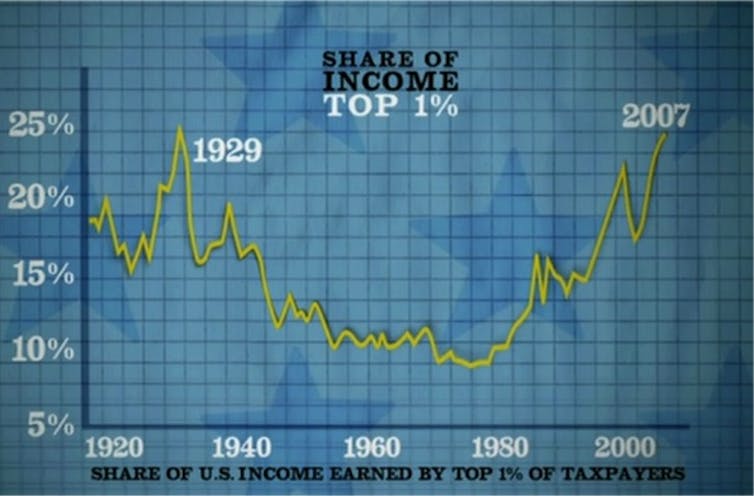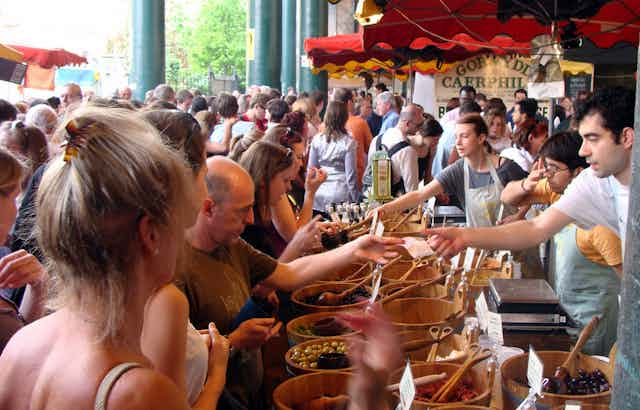Since the 1950s, with a few rare exceptions in the 1970s, the middle class – all over the world – has been getting worse off. Specifically, the middle class’ purchasing power, as with that of the working class, has been gradually deteriorating.
Over the past 50 years, increases in salaries and wages have failed to keep up or catch up with the pace of inflation. Once upon a time, both skilled and unskilled employees were paid enough to support the needs of a family with just one breadwinner. Now, it is far more likely that middle class households depend on two (or more) income earners, with little left over for savings. At the same time, the average size of a family (in the western world at least) has shrunk; the number of children per family has fallen significantly in the past 20 years. So why are we struggling more today than in the past?

One reason may have to do with what we call the “transfer economy”. If we look at the US, still the largest democracy in the world in economic terms at least, 50% of the country’s GDP was transferred from the bottom 90% of the taxpayers to the richest 1% of Americans in the last 30 years. According to Economic Policy Institute analysis of productivity data from the Bureau of Labor Statistics, wealth has simply stopped reaching the working class to transfer towards the upper end of the economic pyramid.
A constant concentration
This shift did not take place secretly, or under the cover of darkness – it took place in front of everyone’s eyes under popularly elected governments. But what is more perplexing is that this “transfer” continues to occur, despite policies and programs to aid the economically challenged. It is happening all over the world.

According to a recent report by Credit Suisse, on a global scale, 32 million individuals, roughly just 0.7% of the world’s population, together hold US$98.7 trillion, representing 41% of the monetary wealth on the planet. In Russia, 35% of the country’s wealth lies in the hands of just 110 individuals.
For decades, we believed that hard work and an education would get us ahead and catapult ourselves to a better life. We indulged ourselves with illusions of growth, and the idea that most of us, if not all of us, would continue to achieve a higher and higher standard of living. We did not understand that we were being fed economic fairy tales. If we had paused before taking another slug of the kool-aid, we might have thought to ask who among us were truly benefiting.
This is what we mean by “transfer economy”. The middle class has not become poorer solely because of financial crises, economic downturns, austerity, or cut-throat competition from emerging economies; it has gradually lost out because wealth has been transferred into the hands of the richest.
Let’s look at the evidence drawn from the recent Wealth X and UBS Ultra Wealth Report. This report takes a global look at individuals with net assets of US$30 million or more, a threshold that is described as “Wealth X”, essentially code for the richest people on earth. What we specifically wanted to know was how much wealth exactly has shifted to rich from the “non-rich”. The extent of the transfer is a bit surprising.
Ever since the economic crisis of 2008, the EU has been suffering from various social and economic difficulties. One would imagine then that everyone would be doing less well as a consequence. Yet, the number of individuals who have increased their wealth to the Wealth X level is actually on the rise by 10%, just in this past year alone. Individual countries offer an even more telling story. The number of people at Wealth X has grown by 7% just last year in Italy, which has been in nothing less than a permanent state of economic limbo. Portugal’s story is similar; the number of people reaching Wealth X has increased by 11%. And it is the same figure in Greece, easily the hardest hit country in the Eurozone during the economic crisis. Worryingly, this seems to be the case everywhere.
Earning a (pie) crust
The middle class is not worse off than before because the financial “pie” has been shrinking, but because its own portion is now much smaller, the pie has been re-sliced. This is why we need to re-think our notions of wealth creation and welfare enhancement.
We need to reform the structure that has made it more possible than ever before to easily shift wealth from those with less to those with much, much more. We need to change our strategic economic modelling and foresight; we need to question what has long been our unquestioning belief in the free market theory. It has helped us achieve economic value and growth, benefiting many people all over the world. But we must also recognize and talk about its failures, without political agendas or manipulation.
The trouble with the fundamental mechanism of our economy is that capital plays a much too important role. In the past, capital owners invested in projects that paid wages to laborers who have very little capital of their own. But as competition soared, especially from emerging markets, wages bore the brunt of efforts to cut costs. But wages are not diamonds, and can only withstand intense pressure for so long. As a result, it has become increasingly difficult for capital holders to obtain a desirable return. Less than ideal returns propelled capital holders to use their resources in a different way: they lend money to non-capital holders.
At the same time, societal pressures encourage people to desire more “stuff” and to take on more debt in order to achieve what they deem to be a “normal” standard of living. Worse yet, governments, in an attempt to boost GDP, continue to encourage us to borrow so that consumers can continue their consumption sprees unabated. It’s not hard to see this cycle simply generates returns for lenders, and thereby transfers more wealth to the capital owners. The result: household debt is the on rise again in Europe.
No more Robin Hoods
It is imperative that we open our eyes to this cycle so that we can break it. We need to migrate to a model that honors the way things really work, distancing our economic strategies from the finance-based economy towards a more territorial economy, or real economy.
As long as the transfer economy persists, it will continue to generate more benefits for those who are closer to wealth – namely the network of financial institutions – through the mechanism of “making money from money”. Without any assertive intervention the transfer economy will mean the pie will become even more disproportionately cut.
A disruption of the transfer dynamic is necessary if we want to reverse the growing economic disparity that places the 1% at the top on an unreachable pinnacle. Over the past 30 years, governments have tried to ease the disparity crisis by re-distributing wealth through taxes – collecting more from the rich to give more financial aid to the poor. This might generate excellent sound bites for governments who can take on the mantle of Robin Hood, this is actually very inefficient.
It creates what economists call “dead-weight loss” – the amount of money that governments have to spend in order to do the actual collection and follow through with re-distribution. Any system that does not equally support its elements is doomed to collapse. If we do not raise more awareness and take action, an irrevocable shift will happen.

